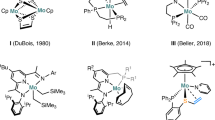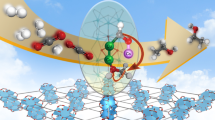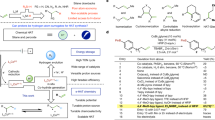Abstract
Catalytic hydrogenation of organic carbonates, carbamates and formates is of significant interest both conceptually and practically, because these compounds can be produced from CO2 and CO, and their mild hydrogenation can provide alternative, mild approaches to the indirect hydrogenation of CO2 and CO to methanol, an important fuel and synthetic building block. Here, we report for the first time catalytic hydrogenation of organic carbonates to alcohols, and carbamates to alcohols and amines. Unprecedented homogeneously catalysed hydrogenation of organic formates to methanol has also been accomplished. The reactions are efficiently catalysed by dearomatized PNN Ru(II) pincer complexes derived from pyridine- and bipyridine-based tridentate ligands. These atom-economical reactions proceed under neutral, homogeneous conditions, at mild temperatures and under mild hydrogen pressures, and can operate in the absence of solvent with no generation of waste, representing the ultimate ‘green’ reactions. A possible mechanism involves metal–ligand cooperation by aromatization–dearomatization of the heteroaromatic pincer core.
This is a preview of subscription content, access via your institution
Access options
Subscribe to this journal
Receive 12 print issues and online access
$259.00 per year
only $21.58 per issue
Buy this article
- Purchase on Springer Link
- Instant access to full article PDF
Prices may be subject to local taxes which are calculated during checkout





Similar content being viewed by others
References
Ito, M. & Ikariya, T. Catalytic hydrogenation of polar organic functionalities based on Ru-mediated heterolytic dihydrogen cleavage. Chem. Commun. 43, 5134–5142 (2007).
Clapham, S. E., Hadzovic, A. & Morris, R. H. Mechanisms of the H2-hydrogenation and transfer hydrogenation of polar bonds catalyzed by ruthenium hydride complexes. Coord. Chem. Rev. 248, 2201–2237 (2004).
O, W. W. N., Lough, A. J. & Morris, R. H. The hydrogenation of molecules with polar bonds catalyzed by a ruthenium(II) complex bearing a chelating N-heterocyclic carbene with a primary amine donor. Chem. Commun. 46, 8240–8242 (2010) and references therein.
Zhang, J., Leitus, G., Ben-David, Y. & Milstein, D. Efficient homogeneous catalytic hydrogenation of esters to alcohols. Angew. Chem. Int. Ed. 45, 1113–1115 (2006).
Saudan, L. A., Saudan, C. M., Debieux, C. & Wyss, P. Dihydrogen reduction of carboxylic esters to alcohols under the catalysis of homogeneous ruthenium complexes: high efficiency and unprecedented chemoselectivity. Angew. Chem. Int. Ed. 46, 7473–7476 (2007) and references therein.
Núñez Magro, A. A., Eastham, G. R. & Cole-Hamilton, D. J. The synthesis of amines by the homogeneous hydrogenation of secondary and primary amides. Chem. Commun. 43, 3154–3156 (2007).
Balaraman, E., Gnanaprakasam, B., Shimon, L. J. W. & Milstein, D. Direct hydrogenation of amides to alcohols and amines under mild conditions. J. Am. Chem. Soc. 132, 16756–16758 (2010).
Schaffner, B., Schaffner, F., Verevkin, S. P. & Borner, A. Organic carbonates as solvents in synthesis and catalysis. Chem. Rev. 110, 4554–4581 (2010).
Kocienski, P. J. Protecting Groups 3rd edn (Thieme, 2005).
Ito, M., Koo, L. W., Himizu, A., Kobayashi, C., Sakaguchi, A. & Ikariya, T. Hydrogenation of N-acylcarbamates and N-acylsulfonamides catalyzed by a bifunctional [Cp*Ru(PN)] complex. Angew. Chem. Int. Ed. 48, 1324–1327 (2009).
Gormley, R. J., Rao, V. U. S. & Soong, Y. Methyl formate hydrogenolysis for low-temperature methanol synthesis. Appl. Catal. A 87, 81–101 (1992) and references therein.
Iwasa, N., Terashita, M., Arai, M. & Takezawa, N. New catalytic functions of Pd and Pt catalysts for hydrogenolysis of methyl formate. React. Kinet. Catal. Lett. 74, 93–98 (2001) and references therein.
Grey, R. A., Pez, G. P. & Wallo, A. Anionic metal hydride catalysts. 2. Application to the hydrogenation of ketones, aldehydes, carboxylic acid esters, and nitriles. J. Am. Chem. Soc. 103, 7536–7542 (1981).
Bart, J. C. J. & Sneeden, R. P. A. Copper-zinc oxide-alumina methanol catalysts revisited. Catal. Today 2, 1–124 (1987).
Ertl, G., Knözinger, H., Schüth, F. & Weitkamp, J. Handbook of Heterogeneous Catalysis 3rd edn, Ch. 13.13 (Wiley-VCH, 2008).
Lee, J. S., Kim, J. C. & Kim, Y. G. Methyl formate as a new building block in C1 chemistry. Appl. Catal. 57, 1–30 (1990).
Girolamo, M. D. et al. Methanol carbonylation to methyl formate catalyzed by strongly basic resins. Catal. Lett. 38, 127–131 (1996).
Delledonne, D., Rivetti, F. & Romano, U. Oxidative carbonylation of methanol to dimethyl carbonate (DMC): a new catalytic system. J. Organomet. Chem. 448, C15–C19 (1995).
Delledonne, D., Rivetti, F. & Romano, U. Developments in the production and application of dimethyl carbonate. Appl. Catal. A 221, 241–251 (2001).
Ma, J. et al. A short review of catalysis for CO2 conversion. Catal. Today 148, 221–231 (2009).
Jiang, Z., Xiao, T., Kuznetsov, V. L. & Edwards, P. P. Turning carbon dioxide into fuel. Phil. Trans. R. Soc. A 368, 3343–3364 (2010).
Jessop, P. G., Ikariya, T. & Noyori, R. Homogeneous hydrogenation of carbon dioxide. Chem. Rev. 95, 259–272 (1995).
Leitner, W. Carbon dioxide as a raw material: the synthesis of formic acid and its derivatives from CO2 . Angew. Chem. Int. Ed. 34, 2207–2221 (1995).
Jessop, P. G., Joó, F. & Tai, C. C. Recent advances in the homogeneous hydrogenation of carbon dioxide. Coord. Chem. Rev. 248, 2425–2442 (2004).
Federsel, C., Jackstell, R. & Beller, M. State-of-the-art catalysts for hydrogenation of carbon dioxide. Angew. Chem. Int. Ed. 49, 6254–6257 (2010).
Jessop, P. G., Hsiao, Y., Ikariya, T. & Noyori, R. Homogeneous catalysis in supercritical fluids: hydrogenation of supercritical carbon dioxide to formic acid, alkyl formates, and formamides. J. Am. Chem. Soc. 118, 344–355 (1996).
Yu, K. M. K., Yeung, C. M. Y. & Tsang, S. C. Carbon dioxide fixation into chemicals (methyl formate) at high yields by surface coupling over a Pd/Cu/ZnO nano catalyst. J. Am. Chem. Soc. 129, 6360–6361 (2007).
Federsel, C. et al. A well-defined iron catalyst for the reduction of bicarbonates and carbon dioxide to formates, alkyl formates, and formamides. Angew. Chem. Int. Ed. 49, 9777–9780 (2010).
Tanaka, R., Yamashita, M. & Nozaki, K. Catalytic hydrogenation of carbon dioxide using Ir(III)–pincer complexes. J. Am. Chem. Soc. 131, 14168–14169 (2009).
Evans, J. W., Casey, P. S., Wainwright, M. S., Trimm, D. L. & Cant, N. W. Hydrogenolysis of alkyl formates over a copper chromite catalyst. Appl. Catal. 7, 31–41 (1983).
Monti, D. M., Cant, N. W., Grimm, D. L. & Wainwright, M. S. Hydrogenolysis of methyl formate over copper on silica. J. Catal. 100, 28–38 (1986).
Gormley, R. J., Rao, V. U. S. & Soong, Y. Methyl formate hydrogenolysis for low-temperature methanol synthesis. Appl. Catal. A 87, 81–101 (1992) and references therein.
Iwasa, N., Terashita, M., Arai, M. & Takezawa, N. New catalytic functions of Pd and Pt catalysts for hydrogenolysis of methyl formate. React. Kinet. Catal. Lett. 74, 93–98 (2001) and references therein.
Monti, D. M., Kohler, M. A., Wainwright, M. S., Trimm, D. L. & Cant, N. W. Liquid phase hydrogenolysis of methyl formate in a semi batch reactor. Appl. Catal. 22, 123–136 (1986).
Sakakura, T. & Kohno, K. The synthesis of organic carbonates from carbon dioxide. Chem. Commun. 45, 1312–1330 (2009).
Sakakura, T., Choi, J. C. & Yasuda, H. Transformation of carbon dioxide. Chem. Rev. 107, 2365–2387 (2007).
Federsel, C., Jackstell, R., Boddien, A., Laurenczy, G. & Beller, M. Ruthenium-catalyzed hydrogenation of bicarbonate in water. ChemSusChem. 3, 1048–1050 (2010).
Abla, M., Choi, J. C. & Sakakura, T. Halogen-free process for the conversion of carbon dioxide to urethanes by homogeneous catalysis. Chem. Commun. 37, 2238–2239 (2001).
Abla, M., Choi, J. C. & Sakakura, T. Nickel-catalyzed dehydrative transformation of CO2 to urethanes. Green Chem. 6, 524–525 (2004).
Zhang, J., Leitus, G., Ben-David, Y. & Milstein, D. Facile conversion of alcohols into esters and dihydrogen catalyzed by new ruthenium complexes. J. Am. Chem. Soc. 127, 10840–10841 (2005).
Gunanathan, C., Ben-David, Y. & Milstein, D. Direct synthesis of amides from alcohols and amines with liberation of H2 . Science. 317, 790–792 (2007).
Gnanaprakasam, B., Zhang, J. & Milstein, D. Direct synthesis of imines from alcohols and amines with liberation of H2 . Angew. Chem. Int. Ed. 49, 1468–1471 (2010).
Gnanaprakasam, B., Ben-David, Y. & Milstein, D. Ruthenium pincer-catalyzed acylation of alcohols using esters with liberation of hydrogen under neutral conditions. Adv. Syn. Cat. 352, 3169–3173 (2010).
Milstein, D. Discovery of environmentally benign catalytic reactions of alcohols catalyzed by pyridine-based pincer Ru complexes, based on metal–ligand cooperation. Top. Catal. 53, 915–923 (2010).
Langer, R., Leitus, G., Ben-David, Y. & Milstein, D. Efficient hydrogenation of ketones catalyzed by an iron pincer complex. Angew. Chem. Int. Ed. 50, 2120–2124 (2011).
Gnanaprakasam, B. & Milstein, D. Synthesis of amides from esters and amines with liberation of H2 under neutral conditions. J. Am. Chem. Soc. 133, 1682–1685 (2011).
Gunanathan, C. & Milstein, D. Selective synthesis of primary amines directly from alcohols and ammonia. Angew. Chem. Int. Ed. 47, 8661–8664 (2008).
Gunanathan, C., Shimon, L. J. W. & Milstein, D. Direct conversion of alcohols to acetals and H2 catalyzed by an acridine-based ruthenium pincer complex. J. Am. Chem. Soc. 131, 3146–3147 (2009).
Kohl, S. W. et al. Consecutive thermal H2 and light-induced O2 evolution from water promoted by a metal complex. Science 324, 74–77 (2009).
Olah, G. A., Geoppert, A. & Surya Prakash, G. K. Beyond Oil and Gas: The Methanol Economy (Wiley-VCH, 2006).
Huang, Y. H. & Gladysz, J. A. Aldehyde and ketone ligands in organometallic complexes and catalysis. J. Chem. Educ. 65, 298–303 (1988).
Acknowledgements
This research was supported by the European Research Council under the FP7 framework (ERC no. 246837), by the Israel Science Foundation, and by the MINERVA Foundation. D.M. is the Israel Matz Professorial Chair of Organic Chemistry.
Author information
Authors and Affiliations
Contributions
E.B. carried out catalytic experiments, mechanistic studies and contributed to writing the manuscript. C.G. carried out catalytic experiments and contributed to writing the manuscript. J.Z. prepared and crystallized complex 3. L.J.W.S. conducted the X-ray structural study of complex 3. D.M. carried out the design and direction of the project and contributed to writing the manuscript.
Corresponding author
Ethics declarations
Competing interests
The authors declare no competing financial interests.
Supplementary information
Supplementary information
Supplementary information (PDF 652 kb)
Supplementary information
Crystallographic data for compound 3 (CIF 19 kb)
Rights and permissions
About this article
Cite this article
Balaraman, E., Gunanathan, C., Zhang, J. et al. Efficient hydrogenation of organic carbonates, carbamates and formates indicates alternative routes to methanol based on CO2 and CO. Nature Chem 3, 609–614 (2011). https://doi.org/10.1038/nchem.1089
Received:
Accepted:
Published:
Issue Date:
DOI: https://doi.org/10.1038/nchem.1089
This article is cited by
-
Structure, reactivity and catalytic properties of manganese-hydride amidate complexes
Nature Chemistry (2022)
-
Synergistic effect between CeO2 and Cu for ethylene carbonate hydrogenation
Journal of Porous Materials (2022)
-
Recent advances in metal-organic frameworks for catalytic CO2 hydrogenation to diverse products
Nano Research (2022)
-
Highlights and challenges in the selective reduction of carbon dioxide to methanol
Nature Reviews Chemistry (2021)
-
Synthesis of cyclic carbonates from epoxides and carbon dioxide catalyzed by talc and other phyllosilicates
BMC Chemistry (2020)



